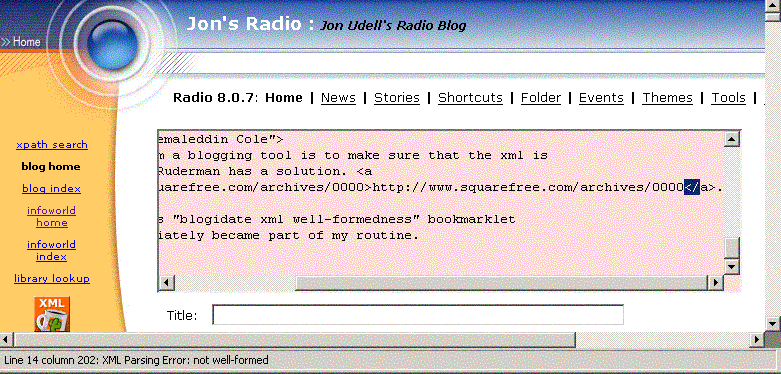The dictionary of the Semantic Web may one day be written. But not until we've done a lot of yammering, a lot of listening, and a lot of imitating. We need to find ways to help these behaviors flourish. [O'Reilly Network]The ideas put forward in this article got a big boost this week when Kimbro Staken revealed Syncato, his way-cool new blog software that's based on XML DB and that uses XPath expressions in its URLs. Today Kimbro released the source code which (I can't resist) you could also find using this search: http://www.xmldatabases.org/WK/blog/item//a[contains (@href, '.gz')].
Another related item I've been meaning to mention comes from Sam Ruby's blog. Referring to an earlier posting of mine on this theme, Sam wrote:
Converging on well formed XML will encourage spontaneous integration. [Intertwingly]In the comments attached to Sam's item, Jemaleddin Cole noted:
If all you want from a blogging tool is to make sure that the xml is well formed, Jesse Ruderman has a solution. http://www.squarefree.com/archives/000033.html".
 I picked up Jesse's "blogidate xml well-formedness" bookmarklet there, and it immediately became part of my routine. Enlarge the screenshot and you'll see it in action, in Mozilla (works in IE too), pinpointing a well-formedness error in a draft of this posting. The red tint tells me there's a problem; the location is highlighted; the parser error shows up in the browser's status line. When I fix the error, I'm green and good to go. Excellent!
I picked up Jesse's "blogidate xml well-formedness" bookmarklet there, and it immediately became part of my routine. Enlarge the screenshot and you'll see it in action, in Mozilla (works in IE too), pinpointing a well-formedness error in a draft of this posting. The red tint tells me there's a problem; the location is highlighted; the parser error shows up in the browser's status line. When I fix the error, I'm green and good to go. Excellent!
Former URL: http://weblog.infoworld.com/udell/2003/09/18.html#a799